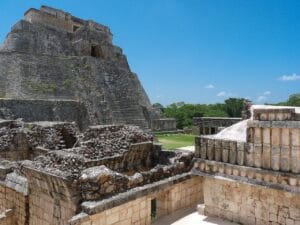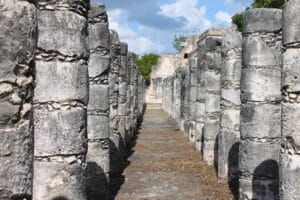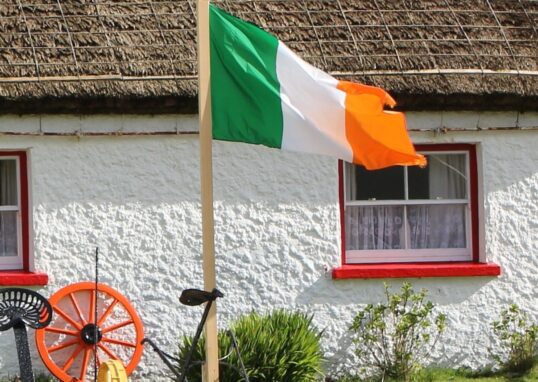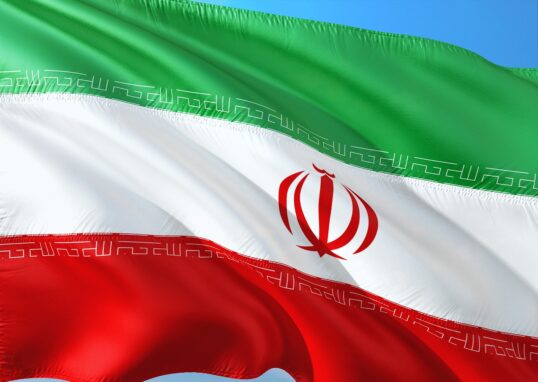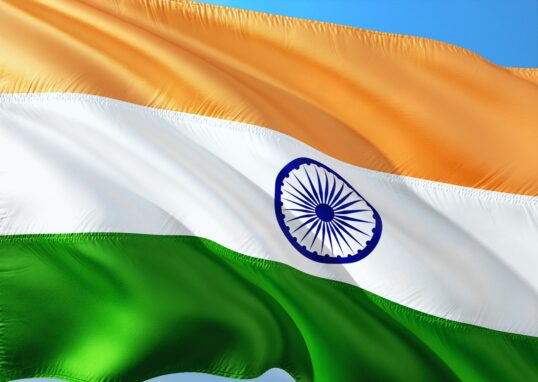
Ancient Maya City and Protected Tropical Forests of Calakmul, Campeche
Hidden deep in the jungles of southern Mexico is one of the world’s greatest of the ancient Maya cities. It is Calakmul, a name that means “City of Two Adjacent Pyramids” in the Maya language. It is located in the Mexican state of Campeche, on the Guatemala and Belize borders. Calakmul is more than a ruin. It is one of the world’s largest tropical reserves, and it is situated within a vast protected area called the Calakmul Biosphere Reserve, which covers more than 7,000 square kilometers of tropical rainforest. It is therefore one of Mexico’s largest tropical reserves. As opposed to other places such as Chichen Itza or Tulum, Calakmul is isolated in a dense jungle. Travelers access the site driving through lengthy roads lined with woods and wildlife. This isolation helped in preserving both the city and its ecosystem intact. In 2002, the Ancient Maya City of Calakmul was recognized as a World Heritage Site by UNESCO. Later on, in 2014, the Protected Tropical Forests of Calakmul were inscribed. Calakmul is now famous for both its history and its beauty.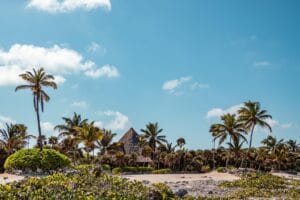
History of the Maya City of Calakmul
Calakmul was one of the powerful cities of the whole of the Maya civilization. It was founded around 500 BCE and existed between 250 CE and 900 CE, when the Classic period of the Maya period was ongoing. The city was occupied by tens of thousands of people. Estimates put as many as 50,000 residing in Calakmul at its height. The city controlled a large region known as the Kingdom of the Snake, since it was named after its royal emblem, the snake head. Calakmul was a rival to the other great Maya city, Tikal, in present-day Guatemala. The two cities fought wars, made alliances with each other, and vied for dominance for centuries. Calakmul typically had an advantage of out-allianceing its rivals by building a coalition of allies from other cities. By the 9th century, like all the other Maya cities, Calakmul began to decline. Wars, changes in trade routes, and environmental factors led to its decline. The city was abandoned, and the jungle consumed its buildings over time.
Architecture and Main Structures
The ruins of Calakmul show the majesty of the Maya constructors. Calakmul has more than 6,000 buildings spread out across the jungle. The most celebrated are the two giant pyramids. The largest, known as Structure II, is about 55 meters high. It is one of the highest Maya pyramids built. Travelers who climb it can see infinite jungle in any direction.
Other important structures are:
- Palaces where rulers and nobility lived. Ball courts used for the sacred Maya ball game. Temples used to worship gods and ancestors. Stelae (stone monuments) with inscriptions of kings and hieroglyphic texts.
The city was planned well with plazas, causeways, and residential areas. Calakmul, archaeologists believe, was not only a political capital but also a cultural and religious one.
Life in the Ancient City
Calakmul citizens led advanced lives. Politics and religion were controlled by nobles and priests, and farmers, artisans, and merchants supported the economy. The Maya also grew maize, beans, squash, and chili peppers. They built reservoirs to store water because rivers are not found in the region. Trade was essential, and Calakmul traded goods such as jade, obsidian, salt, and feathers with other Maya cities. Religion played a major part in life. The Maya believed in many gods representing the sun, moon, rain, and maize. Kings were divine monarchs who communicated with the gods via ritual. Art, music, and literature formed a part of daily life. The Maya used a hieroglyphic system to record events, and most of these writings are still on stelae at Calakmul.
The Protected Tropical Forests of Calakmul
The remains are surrounded by the Calakmul Biosphere Reserve. This colossal forest is one of the largest tropical rainforests in the Americas, after the Amazon. Not only trees are preserved by the reserve, but also rivers, wetlands, and savannas. The reserve is part of the Maya Forest covering Mexico, Guatemala, and Belize. Because of its location and size, the forest provides a refuge for many threatened animals. It is also significant to the climate, as it holds vast amounts of carbon and emits oxygen. Tourists, while walking inside the forest, can hear bird sounds, howler monkeys, and rustling leaves. It is a living museum of biodiversity.
Biodiversity: Plants and Animals
The forests of Calakmul are also full of flora and fauna. Scientists have recorded over 1,500 plant species, 350 bird species, and over 100 mammals.
Some of the wildlife found there includes:
- Jaguars – Calakmul has one of Mexico’s largest jaguar populations.
- Pumas and ocelots – wild cats smaller than jaguars but also present in the forest.
- Baird’s tapir – an enormous herbivore that is not found in great quantities elsewhere in the region.
- Spider monkeys and howler monkeys – regular patrons of trees that line the ruins.
- Scarlet macaws and toucans – colorful birds that bring a splash of color to the jungle top.
There are snakes, crocodiles, and countless insects inhabiting the forest as well. The majority of these animals are threatened by deforestation elsewhere, so protecting Calakmul is vital.
Archaeological Discoveries
Calakmul was first explained to the modern world during the 1930s by American adventurer Cyrus Lundell. Archaeologists have since been uncovering many treasures ever since. Among the most important discoveries was the stash of over 120 stelae, the largest number found in a Maya site. The carvings cover histories of rulers, battles, and rituals. Archaeologists also found jade mask-filled tombs, ceramics, and sacrifices. These finds reflect the opulence and artistry of the Maya elite. Excavations persist to this day, and parts of the city remain under jungle cover. Professionals are of the view that only a small portion of the secrets of Calakmul have been unearthed so far.
Modern Preservation and UNESCO Listing
The Mexican government and UNESCO work together to protect Calakmul. Illegal logging, looting, and global warming threaten the site. By adding both city and forest to its World Heritage listing, UNESCO did something profound: it recognized that culture and nature are interdependent. Calakmul is not just old rocks; it is about the very much alive forest that protected and hid the site. Today, Calakmul is a sustainable tourism model. Numbers are controlled, and sustainable policies are promoted.
Tourism at Calakmul
Going to Calakmul is an adventure. Unlike other sites of the Mayas, it is not crowded. Travelers tend to feel like adventurers as they walk through the ruins. In order to reach Calakmul, one must journey through the jungle. The nearest town is Xpujil, 60 kilometers away. Tourists then take a road that cuts into the reserve sharply. Visitors can climb pyramids, walk around plazas, and listen for the stillness of the forest. Most also make the trip with a safari in the biosphere to see monkeys and birds. Because of its remoteness, Calakmul is unspoiled and authentic. For most travelers, it is the highlight of their visit to Mexico’s Yucatán Peninsula.
Surrounding Places to Visit Near Calakmul, Campeche
Calakmul trip is an experience to cherish. However, the experience is even greater if you explore the neighboring towns, ruins, and villages. Calakmul Biosphere Reserve is located in southern Campeche, near Quintana Roo and Guatemalan border. It abounds in archaeological sites, eco-villages, and cultural towns. Tourists typically follow a visit to Calakmul with others in the area. That is because it allows them not only to appreciate the grandeur of the Maya city but also the wealth of the entire area. A complete listing of the most important surrounding sites follows below.
Xpujil – Gateway to Calakmul
Why Visit Xpujil
Xpujil is the closest town to Calakmul. It is about 60 kilometers from the archaeological site. For most visitors, this small town is the base camp prior to exploring the jungle. The town is small and unassuming, but it has all that a visitor may need—hotels, restaurants, small shops, and fuel stations.
Xpujil Ruins
In the town center, there are the Xpujil ruins. These are smaller than those of Calakmul but very fascinating. The site is famous for its tall towers, which are unusual in Maya buildings. Some of the towers look like tiny skyscrapers in the jungle.
Accommodations in Xpujil
- Hotel Calakmul – economical, clean rooms, ideal for backpackers.
- Casa Ka’an – cabin-style eco-lodge in nature.
- Hotel Villa Calakmul – middle-class hotel with reasonable facilities.
Food Options
Eating places in Xpujil are simple but good. You can find Mexican food like tacos, tamales, and grilled chicken. There is traditional Maya food available in some restaurants as well.
Becan – The Walled City
About Becan
Becan, at only 8 kilometers from Xpujil, is another Maya archaeological site. Becan stands out from other Maya sites because it features fortifications. It had a broad moat surrounding it, making it one of the defense-fortified Maya cities.
Highlights
Visitors are able to walk between the walls, climb pyramids, and look upon plazas. The defense moat shows how well Maya cities were prepared to defend themselves. Becan was also linked with Calakmul and Tikal, so it was an important center.
Visitor Tips
Becan is less crowded than the more famous sites like Tulum or Chichen Itza. You will often have the ruins to yourself to walk around in with not many other people around.
Chicanná – House of the Serpent Mouth
Why It’s Special
Chicanná is near Becan and is the most creative of the area’s Maya ruins. The name means “House of the Serpent Mouth.” That is because the majority of its temple entrance doors are sculpted in the shape of huge monster mouths.
Symbolism
The mouths represent the entrance to the underworld within Maya theology. To pass through the doors is to enter another world. The carvings are highly detailed and well preserved.
Perfect for Photography
Chicanná is small but charming. Its ornamentation makes it a success when it comes to photography and exploring culture.
Río Bec – Unique Architecture
Special Features
Río Bec is another group of Maya ruins near Xpujil. Río Bec is unique in the sense that it has fake stairways and towers. The Maya built tall buildings that looked grand but were climb-proof. These were employed as status symbols and symbols of power.
Archaeological Value
The site provides a glimpse of the imagination of Maya architects. While smaller than Calakmul, it adds to the story of the Maya civilization here in yet another manner.
Calakmul Biosphere Villages
Local Village Eco-Tourism
Some of the local villages around the reserve now have eco-tourism as their specialty. It is here that guests can stay in cabins, take guided tours, and gain insight into local traditions.
Activities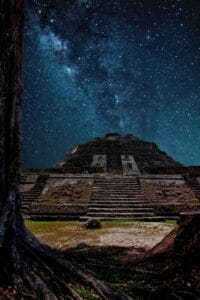
- Birdwatching – catch sight of toucans, parrots, and the occasional scarlet macaw.
- Wildlife tours – lucky you, watch for monkeys, deer, or even jaguars.
- Cultural encounters – learn about traditional farming, handicrafts, and Mayan food.
Examples of Villages
- Conhuas – offers eco-lodges and nature walks.
- Zoh Laguna – reputed for community life and guided jungle walks.
- These villages give you a better idea of what life is like near the Calakmul forest.
Chetumal – Gateway to Belize
Location
Chetumal is about 150 kilometers east of Xpujil. It is the capital of Quintana Roo, located on the Caribbean coast near the border with Belize.
Attractions
Museum of Maya Culture – a great place to learn about Maya history before or after visiting Calakmul.
Bay of Chetumal – a calm waterfront area perfect for evening walks.
Local Markets – colorful markets with food, crafts, and souvenirs.
Hotels
Fiesta Inn Chetumal – mid-range with modern facilities.
Hotel Noor – close to the waterfront, simple and affordable.
Chetumal also serves as a transit point for those traveling to Belize.
Campeche City – Colonial Charm
Location
Chetumal is 150 kilometers east of Xpujil. It is the state capital of Quintana Roo, on the Caribbean Sea near the border with Belize.
Attractions
- Museum of Maya Culture – a useful place to get an introduction to the history of the Maya before or after a visit to Calakmul.
- Bay of Chetumal – a quiet waterfront ideal for a sunset walk.
- Local Markets – colorful markets selling food, crafts, and souvenirs.
Hotels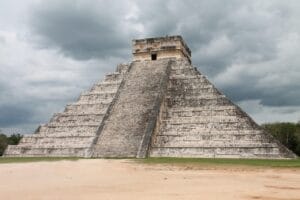
- Fiesta Inn Chetumal – mid-range with modern facilities.
- Hotel Noor – close to the water front, simple and affordable.
- Chetumal is also a stopover for tourists traveling to Belize.
Nature Tours Around Calakmul
There’s more to the forest than ruins and town. The surrounding jungle provides abundant eco-adventures.
Birdwatching Paradise
The Calakmul area is one of Mexico’s premier birdwatching locations. Scarlet macaws, toucans, and dozens of species of hummingbirds inhabit the area. Licensed guides in villages and Xpujil conduct tours.
Wildlife Safari
With guided guides, visitors can spot deer, coatis, peccaries, and occasionally jaguars. Nighttime tours are especially exciting, with the possibility of seeing owls, bats, and nocturnal animals.
Cenotes and Lagoons
While not as popular as in Yucatán, there are cenotes (natural sinkholes) and tiny lagoons near Calakmul. They are ideal for a swim, photography, and a break from sun after exploring ruins.
Travel Tips for Visitors
Best Time to Visit: Dry season (November to April) is the most comfortable. Rainy season (May to October) equates to greener views but also slippery roads.
Transportation: Rental car is the easiest way of exploring. Buses to Xpujil, but taxi or tour required to travel between ruins.
What to Bring: Light clothing, bug spray, sunblock, and plenty of water. Cash, as ATMs are not readily available in small towns.
Guides: Having a guide who is local makes it more rewarding. They share stories, give history, and help spot wildlife.
Conclusion
The Ancient Maya City and Surrounding Protected Tropical Forests of Calakmul is a blend of nature and history like no other. The area offers evidence of a powerful kingdom that dominated the Maya world hundreds of years ago. The forests protect some of Mexico’s richest biodiversity. Visiting Calakmul is like a trip in a time machine. You see pyramids rising above the jungle. You hear the monkeys shouting amidst the trees. You walk where kings and priests have treaded before. And yet, simultaneously, you realize how fragile this inheritance is. The preservation of Calakmul means protecting human heritage and the natural world For travelers seeking adventure, culture, and nature, Calakmul offers all three in one unforgettable experience.

